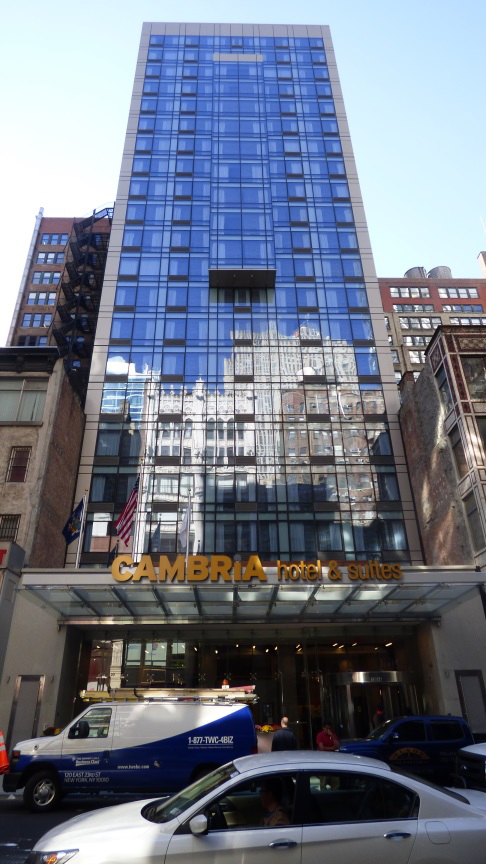News:
Green Buildings
Posted: May 26, 2015
Perkins+Will honors Earth Day with celebration of 20 LEED-certified projects
The New York office of Perkins+Will, a global leader in sustainable building design, honored Earth Day by underscoring their continued commitment to the environment as they celebrated the 20 LEED-certified projects the office has designed over the past decade. Ranging from healthcare and education buildings to workplaces and labs, Perkins+Will's 20 LEED projects total 2 million s/f and span four continents. The projects include Platinum level buildings and certifications across LEED's various rating systems.
Throughout the history of Perkins+Will's growth, sustainability has been a central part of the firm's approach to design, playing a pivotal role in projects of every size and typology. "As environmental destruction and global climate change become increasingly difficult global challenges, we see sustainability - as well as resiliency - playing an even larger role in how our clients measure success," said Paul Eagle, managing director of Perkins+Will's N.Y. office. "We have always believed that sustainability is simply good design, and these 20 LEED projects demonstrate our commitment to delivering on the firm's guiding principles that each of us truly believes in - on Earth Day and every day."
While much attention on LEED benefits relates to the building and its occupants and environment, there is business benefit to building owners and developers also. LEED-2 certified, high-performing buildings and their related lower operating costs and better indoor environmental quality are more attractive to a growing group of corporate, public and individual buyers, and offer a competitive differentiator, according to the U.S. Green Building Council (USGBC).
Increasingly, sustainable features are also becoming part of tenant discussions about purchasing properties, with class A office space typically ranging from average to 20% above average, and owners of sustainable buildings reporting a 19.2% improvement on ROI for existing building green projects and 9.9% on average for new projects. A global survey on corporate social responsibility conducted Nielsen found more than half (55%) of participants noting they are willing to pay extra for products or services that are committed to positive social and environmental impact - an increase from 50% in 2012 and 45% in 2011.
The 20 LEED certified projects - located in five states (N.J., N.J., Conn., Penn. and MD) and on four continents (North America, Australia, Asia and South America) - include six healthcare projects and two hospitals, eight workplaces and six higher education facilities, including one laboratory. The projects range in scale, too, with Connecticut's Gateway College and Pennsylvania's Einstein Medical Center both on the large end - 360,000 s/f - while the Anthos Porticus office in N.Y. is among the smallest, at 8,000 s/f. The projects include four Platinum, 12 Gold, three Silver and one Certified project, using the USGBC designations. More important, the projects include some notable firsts for LEED certification:
* The first LEED certified ambulatory care building in the world (Discovery Health Center).
* The first LEED certified inpatient healthcare project in NYC (Mount Sinai Medical Center, Pediatric ICU).
* The first public building in Connecticut to achieve LEED Gold (Gateway Community College, New Haven).
* The first CUNY building to achieve LEED Platinum (Lehman College).
* The first LEED Platinum teaching laboratory in NYC (Lehman College).
* Winner of first USGBC Awards, Best of Asia Pacific (1 Bligh, Sydney, Australia).
One of Perkins +Will's core beliefs - that sustainable design provides not only environmental benefits but economic, health and safety and community benefits as well - means that the firm takes a holistic approach to building design. By enhancing building occupant health and comfort, minimizing strain on local infrastructures and improving the quality of occupant health, clients also improve their economic bottom line.
The following are a few of the ways Perkins+Will's New York office partners with clients to create a healthy, safe environment and economic bottom line:
* Resilient Design and Climate Adaptation: Working with clients to identify vulnerabilities and to create designs that achieve stability and adaptability.
* Regenerative Design and High Performance Buildings: The firm aims to create systems that are waste free and actually restore resources the environment.
* Transparency and Material Health: Perkins+Will initiated the first on-product ingredient label for building materials.
* Sustainable Communities: The firm's Urban Design practice is pioneering the latest thinking in vibrant, sustainable cities and health districts (as evidenced by the recent winning of 2015 National Planning Excellence Award for a Planning Firm by the American Planning Association).
* Water Resources: Across scales, from building to site to community, Perkins+Will designs systems that harvest, cleanse, and make the most effective use of our most necessary resource: water.
Fast Company magazine recently ranked Perkins+Will as one of "the World's 10 Most Innovative Companies in Architecture." Through research, tool development, design and services, the firm remains committed to working with clients to achieve, and often exceed, sustainability goals.
The White House calls upon the expertise of Perkins+Will, too. A new healthcare report and toolkit for President Obama's Climate Action Plan debuted this month during National Public Health Week, authored by Perkins+Will's Sustainable Healthcare Design Leader, Robin Guenther, FAIA, LEED AP. The interactive toolkit helps communities and hospitals understand their climate risks and protect their facilities and systems during extreme weather events (https://toolkit.climate.gov).
In addition to many years of established success in sustainable design, Perkins+Will offers Sustainable Advisory Services that include research, consultation, and analysis related to sustainable planning, policy, and branding. The results help building owners and operators ensure that their buildings perform to their full potential.
"Designers, as well as the public at large, have come a long way since the first Earth Day in understanding the impact we - as well as our buildings - have on the environment. It is our mission that along with our client partners, will continue to strive for ideas and strategies that will help further sustainable, thoughtful design," Eagle said.
Tags:
Green Buildings
MORE FROM Green Buildings
IREON Insights: DURA Architectural Signage manufactures and delivers over one million signs
Long Island City, NY Since its founding in 1955, IREON member DURA Architectural Signage has proudly manufactured and delivered more than one million signs to clients across a wide range of industries. From architectural interior signage to large-scale exterior installations, their work can be seen in corporate








.gif)

.gif)
.jpg)
.gif)